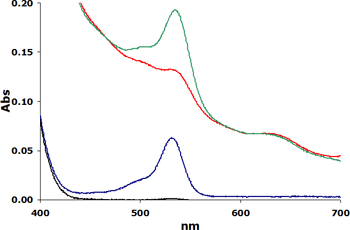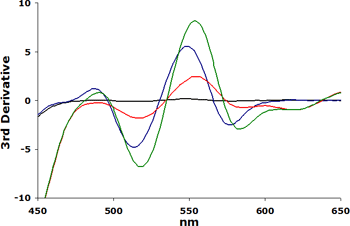Appropriate analysis of the spectrophotometric data is essential to the success in estimating an analyte in a complex biological sample. Such samples can show a severe non-linear baseline, making it difficult to accurately estimate the analyte concentration. For example, malondialdehyde (MDA) was assayed in a bovine muscle homogenate using the NWLSS™ MDA01 standard method. To enhance the signal, a known amount of MDA was added to the same muscle homogenate. The Figure 1 shows the zero order (absorbance vs. wavelength) spectra of the reaction mixtures, including the 1 µM MDA standard and a buffer blank.

Figure 1. Zero order spectra of reaction mixtures: 1 µM MDA, muscle, muscle plus 1 µM MDA and buffer.
|

Figure 2. Third derivative spectra of reaction mixtures: 1 µM MDA, muscle, muscle plus 1 µM MDA and buffer.
|
As is apparent in the zero order spectra obtained from the reaction mixtures, there is a large matrix affect due to scattering and non-specific absorbing components. This effect is not eliminated by sample blanking, simple extraction or two or point baseline correction methods. To address this problem, Botsoglou (J. Agric. Food Chem, 42:1931-1937; 1994) applied derivative spectroscopy to the analysis of MDA in complex samples. Figure 2 shows the third derivative of the reaction mixtures.
Derivative spectroscopy can appear to be mysterious and somewhat intimidating. In addition, not all spectrophotometer manufacturers provide software that is suitable for analysis of spectra such as that obtained in the MDA assay. NWLSS™, in collaboration with Analytic Animations, has developed an interactive online derivative spectroscopy application based on the Savitzky-Golay method (Anal. Chem. 36:1627-1639; 1964). The application allows the investigator to upload spectral data, select analytical parameters, assign calibrator valuess and calculate the analyte concentration in unknown samples.